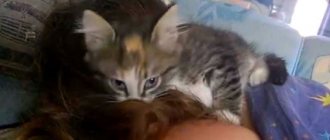Cats have a reputation as the most playful and affectionate, but at the same time obstinate and restless pets. They are active and funny at any age. However, it happens that they suddenly become aggressive towards people. This behavior in pets should be alarming, so it is necessary to find out why cats scratch and bite their owners.
Ten reasons for cat aggression
Like people, cats have individuality, they have their own habits and tastes.
Therefore, there are many reasons for aggressive behavior:
- In kittens aged 3 to 8 months, the cause may be a change in teeth. Their gums itch and there is constant discomfort. Because of this, the baby bites everything that is nearby, even the owner’s hands.
- There is an opinion that too frequent touching causes pain in the animal. This is associated with static electricity, which occurs when a person’s hand comes into contact with a cat’s fur.
- The cat may scream, hiss and scratch due to some illness or injury. In addition, he defends himself in his own way if his paw or tail is stepped on.
- Protest against violence. This often happens during games with children who try to force the pet to sit in their arms, pinch, pull the whiskers and tail, and smother in hugs.
- Fear. This feeling can be caused by the sounds of a vacuum cleaner, a new thing in the apartment, or a stranger. This is especially common in kittens that are taken from their mother too early.
- Jealousy. Pets tend to reject the proximity of other cats or dogs. It happens that the owner returns home, and the smell of a “stranger” emanates from him. This may be the reason for the angry reaction. The cat is unable to take revenge on those whose scent it detects, and directs all its aggression towards the person.
- Familiar games. If a kitten that has just entered the house is allowed to bite and scratch its owner's hand while playing, this habit will remain forever. The difference is that an adult animal, getting into the excitement of the game, bites and scratches very sensitively.
- Stubbornness. A furry pet that is spoiled beyond measure will always insist on its own. He uses his teeth and claws, trying to create his own rules for relations with a person.
- Loneliness. If a pet is often left alone in an apartment, it expresses dissatisfaction by scratching and biting its owners. Cats behave in much the same way when they exhibit sexual instinct.
- To attract attention. The cat wants to be caressed, so it clings to its owner and purrs loudly. If you don’t pay attention to her at this moment or push her away, she may respond with aggression.
Why does my cat scratch while petting?
Contents hide
It is good when everything is good. Imagine this touching picture when a satisfied cat is sitting on your lap, and you are stroking and scratching your mustachioed pet. A cat experiencing true bliss is easy to recognize. The animal looks completely relaxed, its eyes are closed, its ears are turned back, and the purring machine is turned on. The paws, as a rule, are elongated, and you can see claws coming out of them every now and then. Sometimes a cat, being in seventh heaven, begins to knead its paws - “knead the dough.” At the same time, the claws are released in the same way.
Perhaps, let's dwell on the claws in more detail. On the one hand, we are glad that we give pleasure to our mustache. And to be honest, we get no less pleasure from the process. But you have to pay for it: often cats, during bliss and affection, begin to painfully scratch the hands of their owners. And while “kneading the dough,” the claws are already working at full capacity, causing pain. Why is this happening? What makes a cat scratch in moments of pleasure? What to do with all this?
Natural reaction. Cat claws are often compared to human nails - from an anatomical point of view, of course. You will be surprised, but some similarities are indeed visible, especially if you take into account the first two joints of our fingers. Above we described in detail the portrait of a happy, relaxed cat. The act of the animal releasing and retracting its claws is what experts call a “soothing muscle stretch.” The cat enjoys it, it relieves fatigue and stress. The claws can touch the skin of the owners, their clothes, the upholstery of the sofa, etc. They do not dig in in the “classical” sense, they only touch lightly. We humans feel the touch of claws, but we do not feel pain as such. So this behavior can be called scratching very, very conditionally. Another thing is when the claws dig deep into the skin, leaving grooves - scratches. Experienced cat owners know well how this happens.
Reading body language. From publication to publication, we carry over the main thesis: treat mustachioed pets with respect. Give them personal space and try not to violate it. Cats are very delicate animals. They cannot stand rudeness and unceremoniousness. In addition, tailed animals are subject to frequent mood swings. A minute ago they were in the mood for tenderness and caresses, but now it suddenly disappeared. Advice for owners: read the warning signals your pet gives in time. The cat began to “get nervous”, squirm and struggle, its fur stood up, its tail began to move, it began to purr (not to be confused with purring) or hissing - all tactile contacts should be stopped immediately, and the animal should be left alone. Finally, use the good old advice: a cat purrs - it means she is happy, there is no reason to worry. You hear completely different sounds (together with the warning signals we just talked about) - don’t tempt fate, take care of your hands.
Let us note one more important detail. Your cat may scratch completely on purpose. We have considered a situation where an animal experiences pleasure from caresses and naturally releases its claws. But the purrs use their main weapon for a number of reasons. First of all, this is marking. You, of course, know that all cats, without exception, sharpen their claws. If the owners do not bother to find the “right” scratching post, then wallpaper, furniture, door frames and curtains will inevitably suffer. When a cat scratches, it leaves its own unique scent marks on the surface. In addition, the animal performs an exercise called “stretching” - useful both from the point of view of maintaining physical fitness and for raising mood.
But that's not all. Some cats show aggression during petting. True, this is not aggression in its pure sense - such a “special” aggression, expressed in the form of “fake” bites or scratches. Most often, a cat resorts to this model of behavior when she is bored with “tenderness”. Moreover, a loving owner often does not see any warning signals - after all, just a moment ago the tailed friend seemed to be enjoying communication and caresses. Advice: after receiving a “warning” bite or “scratch”, stop the caressing session immediately. To avoid much more dangerous injuries.
What to do, what to do? We note the main thing for ourselves: scratching is an absolutely natural behavior for cats. And in some cases it is easier to prepare for certain inconveniences and be patient. Understand and forgive your pet - most often he scratches not out of malice. And don’t forget about body language: if your hands are covered with deep scratches, then you are clearly overdoing it with caresses.
Don't forget to trim your pet's nails from time to time. Special scissors are sold for these purposes. If you are afraid of hurting your pet, contact a veterinarian or a grooming salon. The procedure is performed approximately once every two weeks. And don’t forget to offer your mustachioed friend scratching posts. One scratching post is clearly not enough - buy several at once, of different types and designs. Place scratching posts in different parts of the house - one of them will definitely suit your mood. If the cat satisfies its “scratching” needs, it means that the owner will have much less energy left over!
Material used: Why Does My Cat Claw Me When I Pet Her? Source: cuteness.com Photo: pixabay.com
Ways to get rid of bad habits
The main advice from experts: do not ignore attacks of aggression in a pet at the earliest stages. His habits should be studied and corrected. In this case, the owner will notice that before the attack, the hair on the back of the cat’s neck stands on end, the back bends, and the look becomes different. We need to look for the most effective ways to stop an attack of aggression. In this case, you should exclude physical impact on your pet and adhere to the following rules:
- Punishment must follow immediately after the attack. After just five minutes, the cat will not understand the owner’s actions; for her it will simply be deliberate humiliation.
- Placing your pet in a confined space, such as a bathroom, is not a good idea. This will create negativity towards the owner.
- The most “terrible”, but acceptable punishment would be slapping with a rolled up newspaper. Punching and kicking are strictly prohibited; they can affect the health of the animal.
- In critical cases, you can use a towel and throw it over the brawler. The sudden darkness calms him.
- Ignoring. Sometimes this works quite effectively: the cat does not tolerate lack of attention. But at the same time, she must understand why she is being punished.
Cat scratches and bites usually take quite a long time to heal. The fur, skin and mucous membranes of animals contain many pathogenic microorganisms that provoke the development of infections and inflammatory processes.
Reduce the damage caused by cat claws
While you're working on methods to stop your carpet from scratching, you'll want to minimize the damage done to your home during this time. Trim your cat's nails regularly using a sharp nail trimmer. This will help keep damage to a minimum.
You can also try a product like Soft Claws plastic nail caps. These should only be used on cats that allow you to interact with their paws.
If you've never used nail caps before, many veterinarians and most large pet stores offer installation and training for a small fee.
Your cat probably won't mind soft nails, and they will prevent damage.
Rules for raising an animal
It is known that cats are touchy creatures and highly susceptible to stress. Therefore, when trying to stop your pet from scratching, it is important to remember the golden rule - you should not yell at, swear at, or physically punish your cat. The animal needs to be raised in a friendly environment and establish warm contact - only this method will give results.
Trusting relationship
Before taking any educational measures, it is necessary to establish a trusting relationship with the cat. Here it should be remembered that a cat “assigns” a friend to itself, considers a person similar to itself and builds appropriate relationships - it can share food, show friendly or even romantic sympathy, entrust its place or, in rare cases, offspring.
Relationships need to be built from a young age - that is, from the moment a kitten appears in the house. But there are cases when a person takes an already adult animal - then friendship must be established gradually, winning the trust of the animal.
The right game
You need to play with your cat with special toys and never with your hands. If a kitten is used to scratching and biting his hands, he will continue to do this into adulthood.
If you had to get an adult cat that has a habit of improper play, you need to gradually wean it from biting and scratching, directing hunting attacks at a ball, ball or toy mouse.
Forming the right reaction
Basically, cats listen to their own instincts, habits and sensations, so it is best to wean your pet from letting out its claws by developing a reaction at the subconscious level.
If you don't like cat scratches, you need to resort to countermeasures that will help the cat understand that human claws are unpleasant. What action does an animal quickly develop a reflex for?
- you can carefully spray water from a spray bottle - not even on the cat, but just nearby;
- create a loud, sharp noise (for example, clapping your hands or hitting the table) - it will distract the cat;
- say sternly and loudly: “No!” or “You can’t!”, but don’t start shouting.
You can combine several techniques at once. This must be done every time the cat scratches in order to maintain a systematic approach. In such cases, the pet develops an understanding: if he scratches or bites, it will be unpleasant. However, if there is a suspicion that the pet is sick or stressed, it is better not to use this method. Eliminate what is bothering your pet, and then educate him.
Eliminating aggression
Often cats scratch and bite due to aggression caused by stress or irritants. If you exclude irritants from the animal’s personal space, there is a high probability that the cat itself will stop showing anger. In this case, educational measures will not be needed. The main thing is to identify the source of stress and try to protect your pet from it.
If aggression is directed at a new family member or concerns a second animal in the house, then a set of measures will be needed to educate and establish a trusting relationship with the cat (if we are talking about a person).
We are taking action
If gentle educational measures don't work and you don't know how to stop your kitten from biting your hands, try the following:
- beanbag;
- sharp bang;
- bottle with water and spray bottle.
You can use an empty plastic bottle filled with coins or buttons as a rattle jar. Every time you see that the kitten is about to attack (or has already grabbed you with its teeth), you need to create a noise that frightens the animal. If you don’t have a rattle at hand, clap your hands loudly and sharply, or with a slipper (palm) on the floor. The "squirter" will force the bandit to take care of his own toilet. Not all cats are afraid of water, but they are surprisingly clean, and using a “squirter” not only does not cause harm to your pet, but also encourages its useful natural instincts. When the kitten runs away, don’t forget to reproachfully say: “you can’t”, “bad boy/girl”, “aren’t you ashamed?” etc.
An important point: the kitten has grabbed your hand with its teeth, purrs and digs its claws in more and more, and you don’t know how to free yourself. You need to do the opposite action of the “prey” - move your hand a little into the mouth of the “predator”. The kitten does not expect such a turn of events and will loosen its grip.
Many kittens love to grab their owner's legs. This can be a real disaster, and there is not always time or opportunity to use rattles and sprinklers. How to stop a kitten from biting its legs? We offer a rather unpleasant for both of you, but quite effective method:
- take a wide patch;
- stick stripes on your legs;
- spread the strips with mustard.
The kitten must learn a lesson: attack - mustard - reprimand. Do not forget to reproachfully reprimand your ward everything that you think about him.
If your cat hunts wild animals, do not let her stay outside for long periods of time.
Hunting rodents and birds is normal behavior for a cat. Their instinct cannot be suppressed, so pets often bring dead animals to their owners. This is how they try to express their love to you. Of course, people are unlikely to appreciate such a gift. But is it possible to stop a cat from hunting?
Unfortunately no. Veterinarians have not yet found a way to help with this. The only way out is to prohibit the cat from walking outside. Then she simply will have nowhere to catch mice and birds.
A few more recommendations
Weaning and training a cat to bite, scratch and lunge is a fascinating activity. But here it is important to remember constant repetition and some patience on the part of the person. Some recommendations will help with this:
- If your pet has an unbridled, wild and hunting character, pay more attention to her, play with her and use different rattles and toys. Such tools instantly distract attention from the hands and feet;
- If the cat already has a persistent habit of rushing and biting, then when his teeth touch your skin, you must immediately stop the game;
- A scratching post can solve the problem, especially if it is equipped with special fishing rods and toys;
- If the cat does not want to learn, use anti-scratch pads - special silicone pads that stick to the paws and prevent harm to others;
- In rare, most advanced cases, you can resort to a special operation to completely remove the cat's claws. But this can be very traumatic for the cat;
- If your pet crosses the line and cannot stop playing, use sounds or try to scare the animal away by throwing a towel over it. Then the cat will remember that bites are fraught with unpleasant consequences.
When raising a cat, it is very important to be patient, not to retreat and not to follow your pet’s lead. The earlier you start training and the more often you repeat the techniques listed above, the less likely it is that your cat will develop bad habits of scratching, biting and lunging. Veterinarians can also help in correcting behavior, but without efforts on the part of the owner, you should not expect results.
All furry pets are small children who need attention, care and education. Therefore, try to be attentive to the requests and needs of cats, but never use aggression or physical punishment. This will only make your relationship with your cat worse; it will become more aggressive and vicious. This will be reflected in relationships with other animals and people around you.
The main reasons for this behavior
In order to overcome the problem, you first need to know why cats scratch furniture, whether this can be considered normal pet behavior, and what contributes to this.
Here are a few main points that will answer these questions:
Physiological need - for the natural replacement of old claws with a keratinized layer with young ones. The process speeds up and becomes less uncomfortable for the animal if it grinds them down.
Warming up and warming up the muscles. An apartment cat needs to keep himself in shape, because nature has a hunter instinct in him, which is limited in a small area. Scratching in this case is the way out.
Territory marker. The paw pads, in contact with the surface of the furniture, leave a characteristic odor that is secreted by the sweat glands. This is how the cat marks its territory in the house.
Relieving tension and stress. Cats are very susceptible and prone to stress, so the cat scratches the furniture, thereby relieving tension.
Instinct. Releasing claws is a skill inherent in genes.
A bit of cat psychology
It’s unpleasant to feel like a “punching bag,” especially if an innocent game ends in festering or scars
It doesn’t matter whether you understand it or not, but an adult cat and even a kitten will always warn of an attack. Already at the age of 3 weeks, kittens cling to each other, roll on the floor and learn to attack the enemy while lying on their backs
Afterwards, the baby moves to a new house, there are no brothers and sisters nearby, and he begins to hone his skills on toys or the owner.
An enterprising owner buys a bunch of toys to please the pet, but the problem is that balls and mice are of no interest to the tailed one. It’s much more interesting for a baby to hide around a corner and suddenly jump to his feet or fight with the owner’s deft hand.
A cat that attacks its owner with rage, on purpose, calculatedly - this is the real problem. In this case, you will really have to work hard, but first you need to find out the reason for the incorrect behavior. Did you know that cat aggression towards humans is a mental disorder? Four-legged animals have lived next to people for dozens of centuries; friendliness or restraint is “hardwired” into the DNA of our pets. There are exceptions to every rule. There are breeds of cats that are prone to squabbles with people, but their incorrect behavior is always understandable:
Dominance - perhaps your pet considers you weaker or views you as a competitor.
Defense - cats suffering from pathologies or mental disorders know about their vulnerability and attack so that they do not have to defend themselves.
Cult of the owner - in this case, the four-legged dog is madly in love with one of the family members and can attack others. The most common example is Siamese cats living with small children. The cat loves and protects the little one so much that it can jump on the face of the parents who scolded the prankster for getting a bad grade.
Revenge - no matter how much you love cats, you need to recognize that they are capable of rancor and resentment. Of course, not all breeds have these qualities or take revenge with “physical violence.”
Deprivation of care or attention is punishment, this is also attention. A desperate pet can actively attack a person, even for the sake of a slap in the face
The specificity of the breed is that hybrids with wild cats are more aggressive and obstinate by nature.
The disadvantage of physical activity is that when the cat has nowhere to direct its energy, it misbehaves, thereby entertaining itself. In the understanding of the ward, nothing bad happens. The owner discovers the upholstery of the sofa torn off or wakes up at night from a bite on the leg.
Shortcomings in upbringing - that is, unintentional encouragement of undesirable actions.
Complexes are the most common cause, which is very difficult to identify.
Many points are so obvious that they are not considered as the cause of a pet’s aggression. Age is a very “blurry” indicator; an owner who knows his pet well can perfectly distinguish the line between anger and pampering of the ward. Next, we will analyze the most complex possible scenarios and methods for correcting behavior.
If the cat refuses to go to the litter box, it needs to be replaced.
Keeping a cat in an apartment requires installing a litter tray. But sometimes the animal refuses to go into it, shitting on the floor or even on the furniture. Again, owners blame the wayward nature of their pets. But veterinarians do not advise drawing hasty conclusions. Perhaps you just picked the wrong tray.
Cats do not like to use small litter boxes with low sides. They feel vulnerable in them. Try purchasing an accessory with high walls, behind which the cat can retire. Do not place the litter box in a crowded place, as this may scare your pet away. A cat will ignore a litter box if it is located close to noisy things, such as a washing machine, oven or microwave.
Also remember that each cat needs a separate container. Dominant animals can frighten weaker ones with their smell, so they will go to the toilet in the wrong place.
Remove the bottom leaves of the tomatoes. Why do gardeners do this?
There will also be electric bicycles: 67 more bike sharing stations will be installed in Moscow
Painted church walls with portraits of his beloved: the secrets of the artist Mikhail Vrubel
If a cat goes to the toilet past the litter box, this may also indicate a disease of the genitourinary system. As a rule, in such cases, urination becomes frequent and painful for the animal.
Brush your cat more often if she frequently vomits hair.
Cats constantly lick themselves, and, as a rule, they do not spit out the fur, but swallow it. Their stomach cannot digest it, so it accumulates in clumps. In turn, they come out along with vomiting. Sometimes a cat vomits almost every day, which, of course, cannot but worry the owner. The situation gets worse during molting.
How to prevent hair vomiting in cats? It's simple: try to comb it more often. Daily brushing is recommended for furry pets. Use special slicker brushes during shedding to remove the bottom layer of fur.
If brushing doesn't help, you can have your cat trimmed by a veterinarian. But remember that frequent vomiting can also be a sign of health problems.
Radical weaning methods
This was a list of the most effective and proven devices and methods, but if even after using them the problem remains, you should use more radical ones:
How to train a kitten to use a litter box - correctly, quickly and easily train a cat to use a litter box (125 photos)- How to raise a kitten - tips and recommendations on how to properly raise an affectionate and tame kitten (135 photos)
How to get rid of the smell of cat urine - 125 photos of ways to remove the unpleasant smell of a cat
- Silicone claw pads. They are attached with special glue and do not create discomfort for the animal, but will last no more than 2 months, then they need to be replaced;
- Thick furniture covers;
- Special materials and coating can stop a cat from scratching doors, wallpaper and furniture. To do this, you can completely or partially cover the area accessible to the furry one with tiles, plastic panels, paint, plaster, fiberglass wallpaper;
- Close the door to the room with your “favorite” place.
If it so happens that you are a resident of an apartment, and not a private house, in which your tailed companion has the opportunity to walk around the yard and perform manicure procedures on trees and other surfaces, without damaging the interior, then learn to understand the mood, feelings and needs of the pet, without use of physical force and punishment.
A cat is a domestic animal with a fairly high level of intelligence, and perhaps it simply lacks the attention and care of its owner.
Constant itching is a sign of an allergy
All cats love to wash themselves. But they don't do this all the time. If a cat nervously licks itself for 1-2 hours, it may suffer from itching. This is also indicated by the habit of scratching the skin to the point of wounds.
Severe itching is often caused by parasites: fleas or ticks. You can find them by running a comb through the fur. Black dirt in the ears is a sure sign of mites.
Often itching is caused by allergies. It can appear due to poor nutrition, the use of aggressive shampoo, or serious illnesses.
How to stop a cat from biting
There are simple ways to stop your cat from biting:
- Play. A kitten is an inexhaustible source of energy. You need to give your pet the opportunity to throw it out and direct it in a peaceful direction. Active play with a ball, a wind-up toy, or a laser pointer will help. Some owners buy a second kitten so that the kids can have fun with each other.
- Take the kitten in your arms. To lose excess energy, the pet can rush around the apartment for a long time, attacking its owners along the way. If you sit him on your lap and stroke him, the baby will calm down and possibly fall asleep.
- Switch attention. This method will not wean the kitten from biting, but will help stop a one-time attack of aggression. It is enough to throw a ball with a rattle, rustling paper or twitch the “mouse” on a string. Another option is to clap your hands, stomp your foot, or make some other harsh sound. However, over time, the pet will get used to the noise and stop reacting to it.
- Ignore the kitten. If the pet bites the owner, the person can pretend that the baby does not exist. That is, do not pay attention to it, even if the animal meows and rubs against its legs. Many cats are very social. This measure makes them think about their own behavior and helps them quickly wean themselves from unwanted habits.
- Eliminate the irritant. Cats do not like strong smells - citrus fruits, vinegar, mustard, etc. The owner can bring the “aroma” of another animal from the street. If this is the reason, then the kitten will stop biting as soon as the owner washes his hands and washes things.
- Punish. If you can’t stop the kitten from biting using peaceful methods, you will have to lightly spank it with a newspaper or spray it with a spray bottle. It is allowed to gently lift the animal by the scruff of the neck for a few seconds, and press the large animal to the floor. The child will understand that his behavior is unacceptable.
Preventive measures are used when the pet only bites an arm or leg. If he has already grabbed onto the owner, there is no need to break free. In the wild this is what prey does. It is better to completely relax and not move. The animal will quickly lose interest.
For your information. If a kitten attacks a sleeping owner, you should send the pet to spend the night in another room. For a few days he may meow pitifully under the door, but he will soon get used to being alone.
Don't give your cat food from the table unless you want her to constantly beg.
It’s unlikely that anyone would like to dine next to a annoying pet who is constantly begging. This is usually encouraged by the owners themselves. They treat cats with their food from time to time, and then are surprised when they begin to demand it.
Veterinarians do not recommend feeding cats from the table. Human food will not benefit your pet, especially if he eats quality food. Fill the bowl before you eat. Then the cat will be busy with his food and will not bother you. If your pet is too stubborn, you can lock him in a separate room during lunch.










